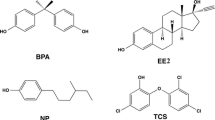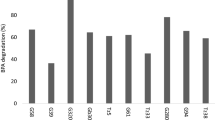Abstract
Bisphenol A (BPA) is an endocrine disruptor compound acting on animals, especially aquatics, and humans. It can leach out of urban and industrial wastes and contaminate the environment. This study evaluated comparatively the decontamination potential of three ligninolytic fungi, Trametes versicolor, Stereum hirsutum and Pleurotus ostreatus, towards BPA at a concentration of 4.6 mg L−1 in distilled water (control) and two freshwaters, a lake water and a river water. The assessment of mycelial growth during water decontamination evidenced a good tolerance of all fungi to BPA and, in some cases, a fungal growth stimulation by the organic content of the two freshwaters, with respect to the control. In the absence of fungi, BPA persistence in water appeared negatively related to the organic matter content of water, resulting in the order: distilled water > river water > lake water. All the three fungi showed a larger removal of BPA in freshwaters with respect to distilled water. T. versicolor and P. ostreatus exerted a similar relevant capacity to remove BPA from both freshwaters, whereas S. hirsutum was much more effective in the decontamination of lake water with respect to river water.
Access provided by Autonomous University of Puebla. Download conference paper PDF
Similar content being viewed by others
Keywords
Introduction
Endocrine disruptor compounds (EDC) are natural and xenobiotic organic molecules responsible for severe alterations of endocrine processes in animals, particularly aquatics, and humans (Staples et al. 1998; Campbell et al. 2006). EDC include natural and synthetic estrogens, pesticides, industrial chemicals, products and by-products of paper, paint and plastic industries. They are particularly spread in highly urbanized and industrialized areas where they can leach out of liquid and solid wastes and contaminate terrestrial and aquatic systems. Several reports are present in the literature on the environmental behaviour of some EDC (Lintelmann et al. 2003; Loffredo and Senesi 2006). Among these compounds, bisphenol A (BPA) is largely used for the production of polycarbonates, epoxy resins and flame retardants. It is also a component of food and drink packaging, electrical and electronic devices and other goods of daily human utilization. BPA is often detected in municipal and industrial wastewaters, sewage sludges and natural waters and sediments (Belfroid et al. 2002). Recently, it has been demonstrated that ligninolytic fungi can biodegrade organic contaminants, such as EDC, by means of their enzymes with low substrate specificity (Cajthaml et al. 2009). No information is available in the literature on the removal of BPA from real water systems using fungi. This work aimed to evaluate comparatively the capacity of three ligninolytic fungi to remove BPA from distilled water, used as control, and two freshwaters, a lake water and a river water. During the biodecontamination process, fungal growth was also monitored in order to assess BPA toxicity.
Materials and Methods
Two Apulian freshwaters were collected from Sassano lake (SLW) and Morelli river (MRW) and analysed for pH, electrical conductivity (EC) and total organic carbon (TOC) content. BPA at a concentration of 4.6 mg L−1 was dissolved in distilled water (control, C), SLW and MRW, and aliquots of 100 mL of each contaminated water were poured separately into sterile plastic pots. These were covered with a dialysis membrane and circles of PDA medium which were inoculated separately with Trametes versicolor, Stereum hirsutum and Pleurotus ostreatus, according to the procedure described in Loffredo et al. (2012). Pots containing only the PDA medium (without fungus) were also prepared for C, SLW and MRW. The pots were kept in an incubation chamber at a constant temperature of 23°C in the dark. All experiments were replicated five times. After 2, 7 and 21 days, the radial growth of the mycelium was evaluated, and the residual BPA was measured by high-performance liquid chromatography and ultraviolet detection (Loffredo et al. 2012). All data obtained were statistically analysed by one-way analysis of variance (ANOVA) and the means of treatments separated by the least significant differences (LSD) test.
Results and Discussion
The main differences between the two freshwaters were relative to EC and TOC. The first was about 100 times higher in MR with respect to SL and that reasonably depended on the proximity of the MR sampling site to the sea, whereas TOC resulted more than five times higher in SLW (4.31 mg L−1) with respect to MRW (0.80 mg L−1), probably for the organic contribution of water runoff from the near town into SLW. Fungal growth on PDA medium laying on C, SLW and MRW added with BPA is shown in Fig. 1. T. versicolor was the most stimulated by the organic content of both freshwaters, whereas S. hirsutum and P. ostreatus grew better on MRW and SLW, respectively. The residual BPA found in the control, SLW and MRW at the three sampling times in the absence or presence on each fungus is reported in Fig. 2. In the absence of fungi, after 21 days, reductions of about 20, 40, and 24% of BPA were observed, respectively, in C, SLW and MRW, which could be attributed to degradation by microorganisms naturally occurring in non-sterile water, diffusion of BPA from water to PDA medium through the membrane and absorption of BPA on the membrane. In general, in the presence of each fungus at any sampling time, the residual BPA in both freshwaters resulted significantly lower than in the absence of the fungus and in distilled water (Fig. 2). All the three fungi contributed markedly to BPA removal from SLW with a similar capacity and trend, whereas S. hirsutum was less effective in MRW. The high initial removal capacity of all the three fungi can be ascribed to the high initial concentration of BPA triggering the expression of ligninolytic enzymes, whereas possible stress conditions occurring later, such as the decrease of nutrients in the growth medium, would reduce this capacity. At the end of experiments, the residual BPA resulted 62% for all the three fungi in distilled water, whereas it was 26, 25, and 15% in SLW and 32, 65, and 34% in MRW in the presence of T. versicolor, S. hirsutum and P. ostreatus, respectively (Fig. 2). In conclusion, results obtained in the present study are very encouraging because they indicate that when biodecontamination from BPA occurs in waters with normal endowment of organic matter, results are even better than those obtained in artificial aqueous media such as distilled water. Further, the experimental protocol used in this work avoids the fungal presence or its migration in the BPA-contaminated water, thus the fungus can be easily removed at the end of the decontamination process.
References
Belfroid, A., M. van Velzen, B. van der Horst, and D. Vethaak. 2002. Occurrence of bisphenol A in surface water and uptake in fish: Evaluation of field measurements. Chemosphere 49: 97–103.
Cajthaml, T., Z. Křesinová, K. Svobodová, and M. Möder. 2009. Biodegradation of endocrine-disrupting compounds and suppression of estrogenic activity by ligninolytic fungi. Chemosphere 75: 745–750.
Campbell, G.C., S.E. Borglin, et al. 2006. Biologically directed environmental monitoring, fate, and trans-port of estrogenic endocrine disrupting compounds in water: A review. Chemosphere 65: 1265–1280.
Lintelmann, J., A. Katayama, N. Kurihara, L. Shore, and A. Wenzel. 2003. Endocrine disruptors in the environment. Pure and Applied Chemistry 75: 631–681.
Loffredo, E., and N. Senesi. 2006. The role of humic substances in the fate of anthropogenic organic pollutants in soil with emphasis on endocrine disruptor compounds. In Viable methods of soil and water pollution monitoring, protection and remediation, NATO sciences series, vol. 69, ed. I. Twardowska et al., 69–92. Dordrecht: Springer.
Loffredo, E., Traversa A., and Senesi N. 2012. Biodecontamination of water from bisphenol A by using ligninolytic fungi and the modulation role of humic acids. Ecotoxicology and Environmental Safety 79: 288–293.
Staples, C.A., P.B. Dorn, G.M. Klecka, S.T. O’Block, and L.R. Harris. 1998. A review of the environmental fate, effects, and exposures of bisphenol A. Chemosphere 36: 2149–2173.
Acknowledgment
This study was financed by University of Bari, Italy.
Author information
Authors and Affiliations
Corresponding author
Editor information
Editors and Affiliations
Rights and permissions
Copyright information
© 2013 Zhejiang University Press and Springer Science+Business Media Dordrecht
About this paper
Cite this paper
Castellana, G., Loffredo, E., Traversa, A., Senesi, N. (2013). The Role of Natural Organic Matter in the Biodecontamination of Freshwaters from the Endocrine Disruptor Bisphenol A. In: Xu, J., Wu, J., He, Y. (eds) Functions of Natural Organic Matter in Changing Environment. Springer, Dordrecht. https://doi.org/10.1007/978-94-007-5634-2_167
Download citation
DOI: https://doi.org/10.1007/978-94-007-5634-2_167
Published:
Publisher Name: Springer, Dordrecht
Print ISBN: 978-94-007-5633-5
Online ISBN: 978-94-007-5634-2
eBook Packages: Earth and Environmental ScienceEarth and Environmental Science (R0)






